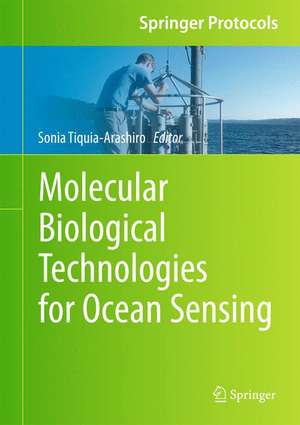Molecular Biological Technologies for Ocean Sensing: Springer Protocols Handbooks
Editat de Sonia M. Tiquia-Arashiroen Limba Engleză Hardback – 12 iul 2012
| Toate formatele și edițiile | Preț | Express |
|---|---|---|
| Paperback (1) | 779.85 lei 43-57 zile | |
| Humana Press Inc. – 23 aug 2016 | 779.85 lei 43-57 zile | |
| Hardback (1) | 648.24 lei 43-57 zile | |
| Humana Press Inc. – 12 iul 2012 | 648.24 lei 43-57 zile |
Din seria Springer Protocols Handbooks
- 18%
 Preț: 782.42 lei
Preț: 782.42 lei - 5%
 Preț: 1817.13 lei
Preț: 1817.13 lei - 18%
 Preț: 1120.18 lei
Preț: 1120.18 lei -
 Preț: 403.91 lei
Preț: 403.91 lei - 15%
 Preț: 662.30 lei
Preț: 662.30 lei - 18%
 Preț: 1855.11 lei
Preț: 1855.11 lei - 18%
 Preț: 1918.09 lei
Preț: 1918.09 lei - 18%
 Preț: 896.08 lei
Preț: 896.08 lei - 15%
 Preț: 644.82 lei
Preț: 644.82 lei - 20%
 Preț: 593.48 lei
Preț: 593.48 lei - 18%
 Preț: 966.27 lei
Preț: 966.27 lei - 5%
 Preț: 2461.71 lei
Preț: 2461.71 lei - 18%
 Preț: 952.09 lei
Preț: 952.09 lei - 5%
 Preț: 737.11 lei
Preț: 737.11 lei - 18%
 Preț: 984.44 lei
Preț: 984.44 lei - 18%
 Preț: 977.34 lei
Preț: 977.34 lei - 18%
 Preț: 1674.20 lei
Preț: 1674.20 lei - 18%
 Preț: 1841.06 lei
Preț: 1841.06 lei - 18%
 Preț: 970.87 lei
Preț: 970.87 lei - 18%
 Preț: 1588.19 lei
Preț: 1588.19 lei - 18%
 Preț: 1029.13 lei
Preț: 1029.13 lei - 5%
 Preț: 677.04 lei
Preț: 677.04 lei - 18%
 Preț: 1250.74 lei
Preț: 1250.74 lei - 5%
 Preț: 723.78 lei
Preț: 723.78 lei - 18%
 Preț: 900.18 lei
Preț: 900.18 lei - 18%
 Preț: 800.55 lei
Preț: 800.55 lei - 15%
 Preț: 645.60 lei
Preț: 645.60 lei - 5%
 Preț: 1487.03 lei
Preț: 1487.03 lei - 15%
 Preț: 645.47 lei
Preț: 645.47 lei
Preț: 648.24 lei
Preț vechi: 762.64 lei
-15% Nou
Puncte Express: 972
Preț estimativ în valută:
124.04€ • 129.84$ • 103.24£
124.04€ • 129.84$ • 103.24£
Carte tipărită la comandă
Livrare economică 31 martie-14 aprilie
Preluare comenzi: 021 569.72.76
Specificații
ISBN-13: 9781617799143
ISBN-10: 1617799149
Pagini: 400
Ilustrații: X, 295 p.
Dimensiuni: 178 x 254 x 22 mm
Greutate: 0.64 kg
Ediția:2012
Editura: Humana Press Inc.
Colecția Humana
Seria Springer Protocols Handbooks
Locul publicării:Totowa, NJ, United States
ISBN-10: 1617799149
Pagini: 400
Ilustrații: X, 295 p.
Dimensiuni: 178 x 254 x 22 mm
Greutate: 0.64 kg
Ediția:2012
Editura: Humana Press Inc.
Colecția Humana
Seria Springer Protocols Handbooks
Locul publicării:Totowa, NJ, United States
Public țintă
GraduateCuprins
Chapter 1. Genome-enabled microbial sensors on ocean platforms.- Chapter 2. Development of a Capillary Waveguide Biosensor Analytical Module for use with the MBARI Environmental Sample Processor.- Chapter 3. MicrofabricatedFlow-Through Device For In Situ Gene Analysis.- Chapter 4. Method for the Quantification of Aquatic Primary Production and Net Ecosystem Metabolism Using In Situ Dissolved Oxygen Sensors.- Chapter 5. DNAzyme-Based Sensing for Metal Ions in Ocean Platform.- Chapter 6. Ultrasensitive Visual Fluorescence Detection of Heavy Metal Ions in Water Based on DNA-Functionalized Hydrogels.- Chapter 7. The Use of Peptide Nucleic Acids in Surface Plasmon Resonance for Detection of Red Tide Algae.- Chapter 8. Immobilization of Fluorescent Aptamer Biosensors on Magnetic Microparticles and Its Potential Application for Ocean Sensing.- Chapter 9. Functional Gene Arrays for Analysis of Microbial Communities on Ocean Platform.- Chapter 10. Bioluminescence detection for ATP quantification using microfluidic device.- Chapter 11. Use of Biosensors as Alternatives to Current Regulatory Methods for Marine Biotoxins.- Chapter 12. Electrochemical Detection of Harmful Algae by Means of a Sandwich Hybridization Assay on an Electrode Surface.- Chapter 13. Waterborne Pathogen Detection Using a MagnetoresistiveImmuno-Chip
Recenzii
From the reviews:
“This is the first book containing detailed information about the use of molecular methods integrated in complex devices/ robots able to act as complex (bio) sensors on autonomous platforms in the ocean. … The detailed and compact information of the present volume can help various kinds of professionals (oceanographers, ecologists, microbiologists or environmental scientists) to both fuel their interest in beginning to work with this kind of devices and contribute to their further development.” (Ioan I. Ardelean, Romanian Journal of Biochemistry, Vol. 51 (1), 2014)
“This is the first book containing detailed information about the use of molecular methods integrated in complex devices/ robots able to act as complex (bio) sensors on autonomous platforms in the ocean. … The detailed and compact information of the present volume can help various kinds of professionals (oceanographers, ecologists, microbiologists or environmental scientists) to both fuel their interest in beginning to work with this kind of devices and contribute to their further development.” (Ioan I. Ardelean, Romanian Journal of Biochemistry, Vol. 51 (1), 2014)
Textul de pe ultima copertă
Back cover copy
The development of ocean sensors remains a ripe area for future investigation from science, policy and systems engineering standpoints. Clearly, there are many options for realizing integrated molecular analytical sensing systems. The definition of key target molecules, detection methods and signal transduction models largely remain to be determined. Moreover, there remains a huge challenge of merging this new class of instrument with different deployment platforms, and supplying necessarypower and data telemetry infrastructure for their operation.
Molecular Biological Technologies for Ocean Sensing features methods papers on the application of ecogenomic sensors on autonomous platforms in the ocean. Topics include the use of ecogenomic sensors as a tool in whole-cell and cell-free based detection and monitoring a suite of pathogens and biotoxins that are of public health concern; documenting species diversity, evolution and metabolic function; identification and quantification of aquatic organisms; and inferring metabolic potential and activities of microorganisms in the ocean. Each contribution focuses on the (1) functional requirements for detecting specific microorganisms and the genes that they harbor and express; (2) examples of research activities that take advantage of molecular detection technologies; (3) some of the challenges faced when projecting development and use of novel instruments that will utilize molecular techniques onboard autonomous platforms;and future directions. Bringing these advancements on autonomous platforms, monitoring required sample collection and processing schemes will differ from those currently used (i.e. biomedical diagnostics).
This book is the first of its kind to compile current technologies for studying organisms in situ. It will aid in transfer technology to oceanographers, ecologists, microbiologists, and environmental scientistswith needs for a remote, in-water sensing capability and for integration with larger scale observatory operations. With this network in place, there is a potential to bridge the gap among regulatory agencies and academics about how this kind of technology can be used for research and monitoring purposes.
The development of ocean sensors remains a ripe area for future investigation from science, policy and systems engineering standpoints. Clearly, there are many options for realizing integrated molecular analytical sensing systems. The definition of key target molecules, detection methods and signal transduction models largely remain to be determined. Moreover, there remains a huge challenge of merging this new class of instrument with different deployment platforms, and supplying necessarypower and data telemetry infrastructure for their operation.
Molecular Biological Technologies for Ocean Sensing features methods papers on the application of ecogenomic sensors on autonomous platforms in the ocean. Topics include the use of ecogenomic sensors as a tool in whole-cell and cell-free based detection and monitoring a suite of pathogens and biotoxins that are of public health concern; documenting species diversity, evolution and metabolic function; identification and quantification of aquatic organisms; and inferring metabolic potential and activities of microorganisms in the ocean. Each contribution focuses on the (1) functional requirements for detecting specific microorganisms and the genes that they harbor and express; (2) examples of research activities that take advantage of molecular detection technologies; (3) some of the challenges faced when projecting development and use of novel instruments that will utilize molecular techniques onboard autonomous platforms;and future directions. Bringing these advancements on autonomous platforms, monitoring required sample collection and processing schemes will differ from those currently used (i.e. biomedical diagnostics).
This book is the first of its kind to compile current technologies for studying organisms in situ. It will aid in transfer technology to oceanographers, ecologists, microbiologists, and environmental scientistswith needs for a remote, in-water sensing capability and for integration with larger scale observatory operations. With this network in place, there is a potential to bridge the gap among regulatory agencies and academics about how this kind of technology can be used for research and monitoring purposes.
Caracteristici
Features methods papers on the application of ecogenomic sensors on autonomous platforms in the ocean The first book of its kind to compile current technologies for studying organisms in situ Aids in transfer of technology to oceanographers, ecologists, microbiologists, and environmental scientists with needs for a remote, in-water sensing capability and for integration with larger scale observatory operations Includes supplementary material: sn.pub/extras












